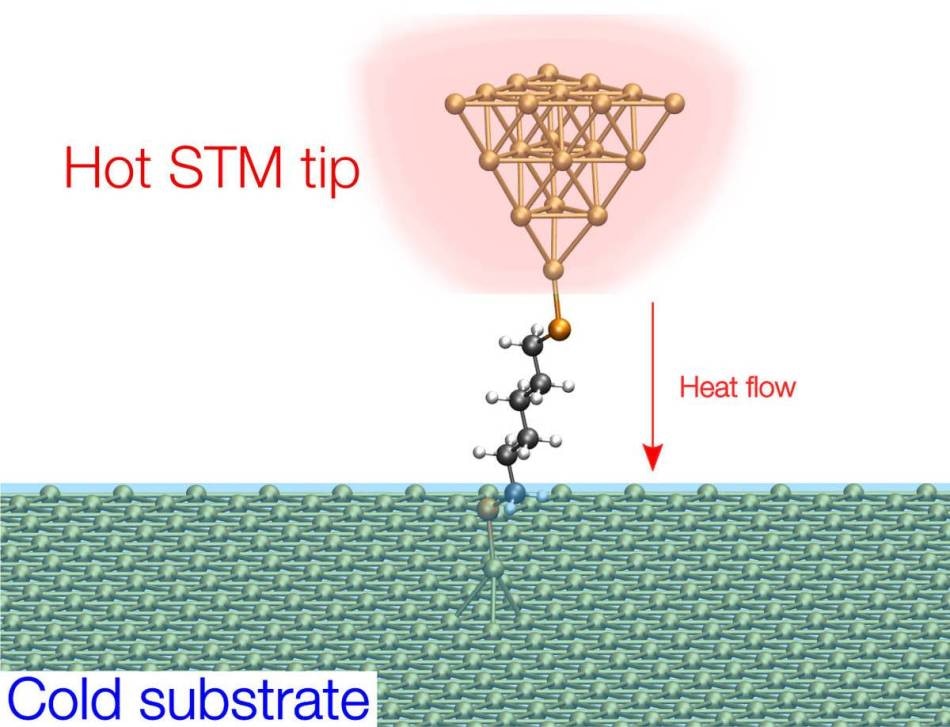Jul 22 2019
Merging new theoretical and experimental methods, scientists from the University of Michigan (USA), Kookmin University (South Korea), the University of Konstanz (Germany), and the Okinawa Institute of Science and Technology Graduate University (Japan) have been successful in measuring and defining the thermal conductance of single-molecule junctions—an important quantity in nanoscale transport phenomena that has until now evaded direct experimental determination.
 Illustration of the experimental setup to measure the heat flow through a single molecule. (Image credit: Jan C. Klöckner)
Illustration of the experimental setup to measure the heat flow through a single molecule. (Image credit: Jan C. Klöckner)
A collaborative paper titled “Thermal Conductance of Single-Molecule Junctions” has been published in the July 17th, 2019 online issue of the journal Nature.
“The control of heat transport at the molecular scale is a key factor in the development of nanostructured materials and technologies such as molecular electronics, thermally conductive polymers, and thermoelectric energy-conversion devices”, explains Associate Professor Fabian Pauly, a theoretical condensed matter physicist and the leader of the Quantum Transport and Electronic Structure Theory Unit at Okinawa Institute of Science and Technology Graduate University.
Fabian Pauly is also a Chief Investigator at the University of Konstanz’s Collaborative Research Centre 767 “Controlled Nanosystems: Interaction and Interfacing to the Macroscale” and contributed the theoretical models for the experimental innovation.
In short molecules, thermal energy transmission is said to be established by phase-coherent, ballistic processes as compared to diffusive and incoherent ones in conventional macroscopic systems.
The problem is that while a range of other single-molecule-level transport properties have been successfully measured in the past, thermal conductance has proven difficult to determine due to considerable challenges associated with detecting extremely small heat currents at picowatt resolution.
Fabian Pauly, Associate Professor and Theoretical Condensed Matter Physicist, Okinawa Institute of Science and Technology Graduate University
Experimental Breakthrough
Researchers from the Department of Mechanical Engineering at the University of Michigan for the very first time have succeeded in effectively measuring thermal transport through single-molecule junctions. They applied a custom-developed calorimetric-scanning-thermal-microscopy method to prototypical thiol-terminated alkane molecules, which were supplied by scientists from the Department of Chemistry at Kookmin University in South Korea.
Functioning in an ultra-high vacuum setting, the US team used a self-assembled monolayer of alkane molecules to enable the development of single-molecule junctions sandwiched between a gold-coated microscope tip and a gold substrate.
The heat transfer from the heated tip to the cold substrate, which was maintained at room temperature all the way through, allowed the scientists to establish the resulting thermal conductance, which was discovered to originate from the vibrations of atoms, also referred to as phonons. An advanced averaging method was needed to compute the small quantity.
The Theory Behind the Experiments
Previous theoretical work conducted in my group made predictions on the size of thermal conductance values for various single-molecule junctions, providing important information to our experimental colleagues regarding the measurement resolution required to achieve successful quantification.
Fabian Pauly, Associate Professor and Theoretical Condensed Matter Physicist, Okinawa Institute of Science and Technology Graduate University
Integrating non-equilibrium Green’s function methods with density functional theory in custom-developed code, Fabian Pauly and his doctoral student Jan Klöckner, who is based at University of Konstanz, were able to measure the thermal conductance because of phonons for junction geometries comprising alkane molecules of variable length.
The experiments with such molecules that were carried out at the University of Michigan produce robust experimental evidence to back the theorists’ notions of a phase-coherent transport regime. “In other words, heat transport in alkane-based single-molecule junctions is virtually independent of length," explains Jan Klöckner, who helped to create the ab initio simulations used to comprehend the experimental data.
These insights help to resolve the age-old problem of establishing thermal conductance at the single-molecule level experimentally. They will also facilitate systematic studies of thermal transport via other one-dimensional systems like polymer chains: “Having shown that heat transport at the molecular scale is length-independent, we must now try to find out how we can enhance or reduce it. Ultimately, what we hope to do in the future is to identify ways of controlling the flow of heat by molecular design,” concludes Fabian Pauly.